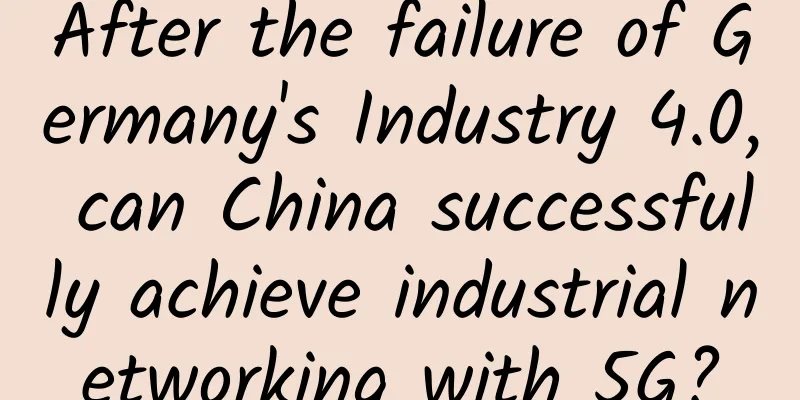After the failure of Germany's Industry 4.0, can China successfully achieve industrial networking with 5G?

|
Key points:
Industrial Internet of Things technology originated in the United States, flourished in Germany, and succeeded with 5G. In 2011, Germany first proposed the concept of Industrial Internet of Things; in 2013, Germany formally established the goal of building the "Industrial Internet of Things" by relying on the CPS system, and called this plan "Industry 4.0". CPS stands for Cyber-Physical Systems, which is translated into Chinese as "information-physical systems". It is a global IoT technology solution that originated in the 3G era. According to the technical plan, it includes CPS IoT chips and CPS operating terminals for chip data. After the birth of CPS technology, the U.S. Congress highlighted the CPS program in a research report in 2005; in February 2006, the American Competitiveness Initiative listed CPS as an important research project; in July 2007, the President's Committee of Advisors on Science and Technology once again listed CPS as the first of the top ten key technologies that will affect the future. As a result, the IoT technology, which was born in the 3G network era, was finally favored by Germany, a wealthy master, in 2013 as the 4G network became popular. This set off a wave of "global industrial IoT movement, which is called Industry 4.0". Six years have passed since 2013. How is the progress of "Industry 4.0", which has rarely been mentioned in the global media? In 2019, with the maturity of 5G technology and NB-IoT solutions, what insights can the "Industrial Internet of Things" solutions of the 4G era bring to China's "Industrial Internet of Things" in the 5G era? If the "Industrial Internet of Things" is realized, what other changes will occur in life for ordinary people like us? Industry 4.0 in Germany 2013 was a special year in the history of China's communications development. At that time, China had just started to build 4G networks, and by the end of the year, only 16 cities had 4G networks. While China was vigorously building 4G network infrastructure, Germany had already proposed the idea of building 4G industrial Internet of Things with CPS system at the beginning of 4G network construction. Although Europe had just experienced the 2008 financial crisis and EU member states had begun to face debt crises, Germany had a rare 20-year low unemployment rate in 2012, and the economy was booming. Therefore, in order to maintain its own industrial competitiveness, the EU's economic engine has "self-initiated" an "Industrial Internet of Things in the 4G Network Era" campaign on the European continent, code-named "Industry 4.0". Industry 4.0 is also called the Fourth Industrial Revolution by countries around the world. According to Wikipedia: Initially steam power was seen as the first industrial revolution; later electricity and mass production assembly technology marked the second; Industry 3.0 brought robots and computers into factories; and Industry 4.0 combines everything into a self-learning, self-correcting system. Therefore, in Germany's Industry 4.0 planning route, factories that have been upgraded to "Industry 4.0" can form a smart factory alliance through the CPS system. According to Germany's plan for Industry 4.0, all factory equipment data are aggregated on the CPS system. Therefore, in addition to predicting the working hours required for maintenance of each machine, the CPS system can also ensure the highest quality and speed of product output by major factories under the CPS system by arranging appropriate work tasks for machines and equipment. In Germany's "Industry 4.0" plan, the CPS industrial Internet of Things solution, in addition to functions such as resource allocation optimization and data monitoring, has the ultimate vision of replacing most workers' manual work and realizing "machine autonomy" in the factory. The test field before 5G, the failure of CPS CPS technology, which carries such a grand technological vision and can make the whole of Germany go all in, is certainly not an "ordinary" technology. In 2013, in addition to the hype from major American institutions from 2005 to 2007, CPS technology can also be found in some practical applications. For example, ultra-modern factories such as Boeing, Airbus, Audi and Mercedes-Benz all have embedded castrated versions of CPS systems. The reason why it is called a castrated version is that the CPS applications in these factories are small hardware systems associated with mechanical equipment, and this hardware system often only processes the operating data of this machine. The CPS that Germany wants to bet on is an "industrial Internet of Things" built by countless machines interconnected. Unlike embedded CPS systems, the "Industrial Internet of Things" version of CPS not only knows the status of all factory machines, but can also automatically analyze and coordinate the work content of factory machines, so that the machines in the entire system can achieve maximum operational efficiency. Therefore, its complexity is thousands of times that of the original embedded CPS system. Due to the complexity of CPS systems, practical cases of CPS only exist in a distributed robot garden at MIT, and there is no large-scale industrial application. However, in order to reap the dividends of the Industrial Internet of Things before the arrival of 5G before other countries in the world, wealthy and willful Germany has also established the "Industry 4.0 Platform" for the construction of CPS systems through the German Mechanical Engineering Association and Manufacturers Association (VDMA). Soon after, the German Electrical, Electronic and Information Technology Association released Germany's first Industry 4.0 standardization roadmap, making the entire "Industrial Internet of Things" construction around CPS look quite formal. However, their pioneering spirit ultimately failed in the face of technological innovation. In 2015, first-tier IC companies such as Intel, Qualcomm, Texas Instruments and Huawei launched NB-IoT technology that can access 5G networks in the field of IoT. In 2016, as more companies supported NB-IoT technology, the world basically abandoned the CPS IoT solution that was only discussed in academic journals. At this point, the CPS Internet of Things chip related to the CPS system has instantly become an isolated object in technological exploration as the IC giants turned around. What killed CPS technology was not only the NB-IoT Internet of Things solution that crushed CPS chips in terms of cost advantage, but also the first-tier giants such as Amazon, IBM, Microsoft and Google that realized the importance of cloud computing in the future 5G era. Early cloud computing had simple functions and could only complement CPS. However, with the advancement of cloud computing technology and its integration with NB-IoT Internet of Things solutions, cloud computing has gradually replaced the data analysis capabilities of CPS systems in future planning. Among them, in 2014, eight technical research experts in mechanical automation predicted through the book "Industrial Cloud-Based Cyber-Physical Systems" that "cloud-based physical networking solutions" would become the future Internet of Things operating system. After the publication of this book, many articles began to emerge on how industrial cloud could replace CPS industrial Internet of Things solutions. In 2015, a scholar even determined the death of the CPS system from a technical perspective through systematic deduction. So even if Germany is not very smart, it can realize belatedly that: "CPS's industrial Internet of Things and Internet of Things solutions have been abandoned by the world." At this point, there are only two possible results for Germany to insist on doing so. One is that it has gone to great lengths to develop an antique industrial Internet of Things solution for the 5G era. The other is that it has to give up halfway due to the huge costs, and has to learn the lesson of "building a car behind closed doors" at a cost of hundreds of billions of dollars. In 2017, Cisco published a survey of German factories, the results of which showed that 76% of German factories believed that the "Industry 4.0 Plan" had failed because they had never participated in any "Industry 4.0" organization. In the 2018 Industrial Internet of Things report released by Gartner in July 2018, there were almost no companies in fields such as transportation, manufacturing, utilities and natural resources participating in the "Industry 4.0" standards. Therefore, the tornado that once brought with it "big data, smart industry and the Fourth Industrial Revolution" has been gradually forgotten by people as time goes by. It was not until the 5G standard was initially established in the past two years that people remembered that in the 3G and 4G era, there was an industrial Internet of Things technology solution called CPS. China's Industrial Internet of Things Process before 5G While major companies in Germany and the United States are vigorously promoting the "Industrial Internet of Things", since no one has 5G technology, Chinese companies are naturally not idle either. However, compared with Germany, when we proposed the "Industrial Internet of Things", we only adopted the "industrial park" exploration model. This compromise follows the principle, on the one hand, of China's vast territory and abundant resources, and on the other hand, of the current state of Chinese enterprises. In 2016, as the country proposed the goal of industrial Internet of Things in "Made in China 2025", that year was basically the time when the domestic discussion on "Industrial Internet of Things" was the most heated. The frequency of discussion and reports were no less than that of 5G network in 2019. Among them, in the answer to "The Prospects of Industrial Internet of Things and Industry 4.0 in China", many netizens (summary of opinions) introduced: The reason why China's manufacturing industry cannot currently carry the Industrial Internet of Things on a large scale is that compared with German factories, Chinese factories are still dominated by medium and low-end manufacturing. The construction cost of the CPS system is very high, so Germany can explore "Industry 4.0" nationwide based on the huge profits of its high-end manufacturing industry and very complete industrial standardization. Given China's current industrial situation, the CPS system, which requires companies to pay for themselves, is destined not to become a nationwide industrial Internet of Things solution due to cost issues. Forcibly promoting the construction of industrial Internet of Things under the CPS system will only increase the production costs of Chinese industrial products, which are already in the red ocean market. When the survival of enterprises is still the main problem, most Chinese enterprises have no intention to try to explore technology. Therefore, although the industrial park-style exploration of the Industrial Internet of Things has helped us avoid the CPS pitfall that Germany encountered in "Industry 4.0", if no new low-cost IoT solutions emerge, China's industrial enterprises will be crushed by Germany's "Industry 4.0" technology for a long time. Of course, it is fortunate that with the birth of low-cost NB-IoT Internet of Things solutions, this kind of crushing has not become a fact that is happening or has already happened on the eve of 5G. Because with the popularization of 5G, the Industrial Internet of Things will break away from the cost constraints of laboratories and become a dividend of the era of the Internet of Everything. 5G has become a key turning point for the Industrial Internet of Things There are two reasons why 5G can promote the popularization of industrial Internet of Things: one is technical reasons, and the other is cost reasons. From a technical perspective, the 5G ecosystem can currently replace the CPS IoT solution. When the CPS system was first introduced, it was just an IoT technology solution that carried a 4G network. Because this technology solution integrated all the functions of "5C (connection, conversion, network, cognition and configuration)", even though it had a complete construction model, there are still few implementation cases due to the complexity of the technology. In fact, as early as March 2015, the National Library of Medicine of the United States National Institutes of Health included an academic paper on the comprehensive discussion of the CPS system. In this professional and technical document that has been cited countless times, the author directly used a model to demonstrate the infeasibility of the CPS system in terms of data conflicts and technical construction. In another article we co-authored with Tencent, "Who will be the biggest winner in IoT chips in the 5G era?", the 5G ecosystem includes: IoT, cloud computing and artificial intelligence. Different from CPS's approach of integrating all 5Cs, the Internet of Things in the 5G ecosystem carries the connection function, cloud computing carries the conversion and network functions, and the latest artificial intelligence carries the cognitive and configuration functions. While the three technical directions form their own industries, they are also interconnected through 5G technology. This makes the implementation of smart IoT much simpler and more convenient than CPS technology. Based on the differences between the two technologies, the IoT chip technology that many giants are betting on is not CPS chips, but the NB-IoT chip solution led by Huawei, Qualcomm and Ericsson in 2015. Therefore, from a technical perspective, the popularity of NB-IoT chip solutions that can be integrated into 5G networks has already put the future of CPS systems in the cold. From a cost perspective, although the overall investment in NB-IoT Internet of Things solutions is not less than that of CPS, because NB-IoT devices will be integrated into the 5G networks of global telecom operators in the future, telecom operators will directly become the promoters of NB-IoT Internet of Things solutions. Therefore, compared with the CPS solution that requires enterprises to invest and build their own network separately, not only do telecom operators help industrial enterprises to pay the bulk of the hardware construction, but even the supporting cloud computing services are helped to be built by technology giants. Among them, with the popularization of NB-IoT IoT devices, the price of building NB-IoT IoT hardware will gradually decrease. This will allow manufacturing companies in the later stages of 5G ecosystem construction to use the industrial IoT technology brought by the 5G ecosystem at zero cost in the future. Behind this comparison, for most enterprises, it is easy to tell which of the two "Industrial Internet of Things solutions" is better. Industrial Internet of Things under 5G In the current industrial system, because we cannot clearly determine the specific quantity of materials and the error range in material production, many times "warehouse waste", "time waste" and "manpower waste" are often just because of not producing a screw or an insignificant part. The Internet of Things system in the 5G era will solve many "one screw" error problems in the existing industrial system through the Internet of Things system. When all factory machines and equipment form a profit-sharing industrial alliance due to the deployment of industrial cloud services, a foreseeable fact is that the product order we placed online 2 hours ago can be produced in the factory in half an hour and delivered in another hour. At that time, the label on JD.com’s product page was no longer “delivered on the same day”, but “produced and delivered on the same day”. In addition to speed, the non-luxury items you buy will also be of better quality and at lower prices due to lower logistics, warehousing and production costs. As factory boundaries are broken down and all factory machines are integrated into an Internet of Things system, future industrial products will become modular. For example, for all complex electronic products before consumers place an order, 60% of the assembly will be completed in the main factory, and the remaining 40% of the work will be completed in the standardized factory closest to you after you place the order. In this way, even if there are some surplus materials, the 60% of available parts can be flexibly combined in the next generation of product updates. Behind this combination, our consumers feel: The number of customized items you can buy for yourself will increase dramatically. For example, when your weight increases, the sugar content of the food you buy will be reduced in advance, and the new tableware you buy will reduce the food carrying volume in advance. The red and black clothes you buy are pre-mixed with your favorite blue and black and crimson. When everything is centered on the personal preferences of consumers, the way businesses, society and economies are organized will be rewritten. However, this process does not happen overnight. When the industrial "Internet of Things System" evolves to this point: the business owner's investment will become a shareholding in the "Industrial Internet of Things" alliance, and the company's managers will shift from worker management to data development management. At that time, the most valuable mortgageable property for the company will not be hardware, but the ownership and use rights of data. In order to reconcile this contradiction, the CPS system has set up a voting system for companies that join the "Industrial Internet of Things". In the 5G era, the processing of this data ownership is evolving towards distributed data centers with the evolution of the industrial cloud. China's Journey to Learn from Germany's Industry 4.0 In April 2019, when all industrial changes seem to have nothing to do with us, although Germany has encountered obstacles in the "Industry 4.0" of CPS technology, China can also realize the "Industrial Internet of Things" through the popularization of 5G. However, compared with Germany's Industry 4.0 movement, Chinese companies still have a lot of "room for improvement in non-industrial IoT" that they should learn from German companies, whether in management model or financial model. For example, many Chinese companies have not yet used the basic "Enterprise Resource Planning ERP". Even if they have EPR, it is unknown how many companies are doing it just for the sake of EPR. This has put most Chinese companies in a private offline mode. Not only do they lack standardization that allows data to be interconnected, but as regional cultural differences increase, the differences in management models and responses to informatization are also increasing. This kind of individual backwardness may be improved in terms of standardization in the storm of the 5G era, but technology can only save technology, but it cannot optimize the core of every enterprise at the forefront of the times - people. Therefore, the gaps in management knowledge and business operation talents among domestic enterprises should be the focus of learning from Germany more than the "Industrial Internet of Things". Looking at Germany's Industry 4.0 plan, instead of just standing by and saying it is on hold, it is better to say: "Germany has the confidence to take the lead in the industrial world because it has money, technology and talent." Besides the current conjectures, when will we have the opportunity to follow up on cutting-edge technologies? |
Recommend
Interpretation of this article: A complete list of interfaces commonly used by engineers
As an engineer, you should often deal with interf...
What to do if you forget your router password? Do it yourself without asking for help
Now we are in the Internet age, the Internet make...
Little-known tips for ordinary users to install broadband at home
In the past two years, broadband has become a mus...
These router phenomena must have troubled you. Take a look and learn more
Does the row of indicator lights on your router o...
Green operation, data center still depends on automation
Power is the lifeline of data centers, and electr...
How to integrate network management tools
In the process of curbing the proliferation of ne...
Eight major IT disasters in 2024
Like most years, 2024 has seen a series of IT dis...
Lisa Host: Los Angeles Cera Data Center CN2 High Defense VPS monthly payment starts at 40 yuan, support 2 yuan/day trial
I shared information about Lisa hosts in the midd...
Why are IDC companies keen on entering the broadband access network field?
Since the country launched the pilot business of ...
How the Network Supports Zero Trust
[[354213]] Building a zero-trust architecture typ...
In the era of the Internet of Things, using DDI to improve security
The era of the Internet of Things has arrived. No...
Huawei releases smart security distribution business strategy and four new AI products
[Shenzhen, China, March 20, 2020] Today, Huawei&#...
Kai-Fu Lee: Under what conditions will artificial intelligence surpass humans?
[51CTO.com original article] In recent years, art...
CAICT answers hot issues on “number portability” service
On November 27, 2019, China Telecom, China Mobile...
JuHost: Hong Kong VPS 40% off from $2.99/month, 1GB/20GB SSD/1TB@100Mbps
JuHost was registered in Hong Kong in early 2023,...









